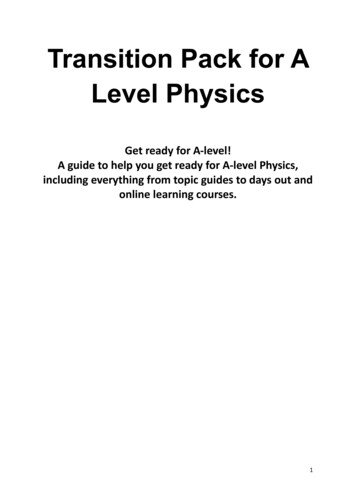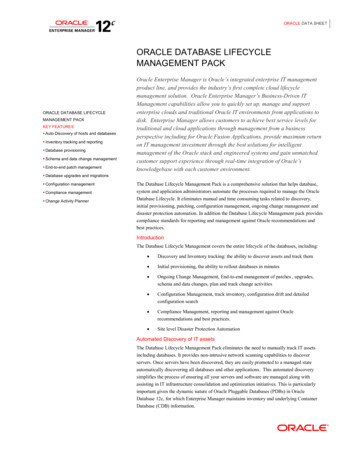
Transcription
Transition Pack for ALevel PhysicsGet ready for A-level!A guide to help you get ready for A-level Physics,including everything from topic guides to days out andonline learning courses.1
Book RecommendationsBelow is a selection of books that should appeal to a physicist – someone with an enquiring mind who wantsto understand the universe around us. None of the selections are textbooks full of equation work (there will beplenty of time for that!) instead each provides insight to either an application of physics or a new area of studythat you will be meeting at A Level for the first time.1.Surely You're Joking Mr Feynman: Adventures of a Curious CharacterISBN - 009917331X - Richard Feynman was a Nobel Prize winning Physicist. In myopinion he epitomises what a Physicist is. By reading this books you will get insightinto his life’s work including the creation of the first atomic bomb and his bongoplaying adventures and his work in the field of particle physics.(Also available on Audio m/surely youre joking mr feynman adventures of a curious character2.Moondust: In Search of the Men Who Fell to EarthISBN – 1408802384 - One of the greatest scientific achievements of all time wasputting mankind on the surface of the moon. Only 12 men made the trip to thesurface, at the time of writing the book only 9 are still with us. The book doesan excellent job of using the personal accounts of the 9 remaining astronautsand many others involved in the space program at looking at the whole spacerace era, with hopefully a new era of space flight about to begin as we push onto put mankind on Mars in the next couple of erm/moondust in search of the men who fell to earth3.Quantum Theory Cannot Hurt You: Understanding the Mind-Blowing Building Blocks of the UniverseISBN - 057131502X - Any Physics book by Marcus Chown is an excellent insightinto some of the more exotic areas of Physics that require no prior knowledge.In your first year of A-Level study you will meet the quantum world for the firsttime. This book will fill you with interesting facts and handy analogies to whipout to impress your ory-cannot-hurt-you/marcuschown/97805713150242
4.A Short History of Nearly EverythingISBN – 0552997048 - A modern classic. Popular science writing at its best. AShort History of Nearly Everything Bill Bryson’s quest to find out everything thathas happened from the Big Bang to the rise of civilization - how we got fromthere, being nothing at all, to here, being us. Hopefully by reading it you will gainan awe-inspiring feeling of how everything in the universe is connected by somefundamental /a short history of nearly everything5.Thing Explainer: Complicated Stuff in Simple WordsISBN – 1408802384 - This final recommendation is a bit of a wild-card – a bookof illustrated cartoon diagrams that should appeal to the scientific side ofeveryone. Written by the creator of online comic XTCD (a great source ofscience humour) is a book of blueprints from everyday objects such as a biro tothe Saturn V rocket and an atom bomb, each one meticulously explained BUTonly with the most common 1000 words in the English Language. This wouldbe an excellent coffee table book in the home of every xplainer/randall-munroe/9781473620919Movie / Video Clip RecommendationsHopefully you’ll get the opportunity to soak up some of the Sun’s rays over the summer – synthesising someimportant Vitamin-D – but if you do get a few rainy days where you’re stuck indoors here are some ideas forfilms to watch or clips to find online.Science Fictions Films1.2.3.4.5.Moon (2009)Gravity (2013)Interstellar (2014)The Imitation Game (2015)The Prestige (2006)Online Clips / Series1.Minute Physics – Variety of Physics questions explained simply (in felt tip) in a couple of minutes.Addictive viewing that will have you watching clip after clip – a particular favourite of mine is “Why isthe Sky Dark at s2.Wonders of the Universe / Wonders of the Solar System – Both available of Netflix as of 17/4/16 –Brian Cox explains the Cosmos using some excellent analogies and wonderful imagery.3
3.Shock and Awe, The Story of Electricity – A 3 part BBC documentary that is essential viewing if youwant to see how our lives have been transformed by the ideas of a few great scientists a little over 100years ago. The link below takes you to a stream of all three parts joined together but it is best watchedin hourly instalments. Don’t forget to boo when you see Edison. (alternatively watch any Horizondocumentary – loads of choice on Netflix and the I-Player)https://www.youtube.com/watch?v Gtp51eZkwoI4.NASA TV – Online coverage of launches, missions, testing and the ISS. Plenty of clips and links to exploreto find out more about applications of Physics in Space .The Fantastic Mr. Feynman – I recommended the book earlier, I also cannot recommend this 1 hourdocumentary highly enough. See the life’s work of the “great explainer”, a fantastic mind that createdmischief in all areas of modern Physics.https://www.youtube.com/watch?v LyqleIxXTpwResearch activityTo get the best grades in A Level Physics you will have to get good at completing independent research andmaking your own notes on difficult topics. Below are links to 5 websites that cover some interesting Physicstopics.Using the Cornell notes system: ml make 1 page of notesfrom each site covering a topic of your choice.a)http://home.cern/aboutCERN encompasses the Large Hadron Collider (LHC) and is the largest collaborative scienceexperiment ever undertaken. Find out about it here and make a page of suitable notes on theaccelerator.b) http://joshworth.com/dev/pixelspace/pixelspace solarsystem.htmlThe solar system is massive and its scale is hard to comprehend. Have a look at this award winningwebsite and make a page of suitable ategory/htmlPhET create online Physics simulations when you can complete some simple experiments online.Open up the resistance of a wire html5 simulation. Conduct a simple experiment and make a onepage summary of the experiment and your findings.4
d) http://climate.nasa.gov/NASA’s Jet Propulsion Laboratory has lots of information on Climate Change and EngineeringSolutions to combat it. Have a look and make notes on an article of your motion.htmlNewton’s Laws of Motion are fundamental laws for the motion of all the object we can see around us.Use this website and the suggested further reading links on the webpage to make your own 1 page ofnotes on the topics.Figure 1: if5
Pre-Knowledge TopicsBelow are ten topics that are essential foundations for you study of A-Level Physics. Each topics has examplequestions and links where you can find our more information as you prepare for next year.Symbols and PrefixesPrefixSymbolPower of tenNanonx 10-9Microμx 10-6Millimx 10-3Centicx 10-2Kilokx 103MegaMx 106GigaGx 109At A level, unlike GCSE, you need to remember all symbols, units and prefixes. Below is a list of quantities youmay have already come across and will be using during your A level ms-2TimetSForceFNResistanceRΩPotential differenceVVCurrentIAEnergyE or hargeQC6
Solve the following:1.How many metres in 2.4 km?2.How many joules in 8.1 MJ?3.7.Convert 632 nm into m. Express in standardform.8.Convert 1002 mV into V. Express instandard form.9.How many eV in 0.511 MeV? Express instandard form.Convert 326 GW into W.4.Convert 54 600 mm into m.5.How many grams in 240 kg?6.Convert 0.18 nm into m.10. How many m in 11 km? Express in standardform.Standard FormAt A level quantity will be written in standard form, and it is expected that your answers will be too.This means answers should be written as .x 10y. E.g. for an answer of 1200kg we would write 1.2 x 103kg. Formore information visit: rite 2530 in standard form.7.Write 2.4 x 10 2 as a normal number.2.Write 280 in standard form.8.Write 3.505 x 10 1 as a normal number.3.Write 0.77 in standard form.9.Write 8.31 x 10 6 as a normal number.4.Write 0.0091 in standard form.10. Write 6.002 x 10 2 as a normal number.5.Write 1 872 000 in standard form.11. Write 1.5 x 10-4 as a normal number.6.Write 12.2 in standard form.12. Write 4.3 x 103 as a normal number.7
Rearranging formulaeThis is something you will have done at GCSE and it is crucial you master it for success at A level. For a recap ofGCSE watch the following for-avariablewww.youtube.com/watch?v WWgc3ABSj4Rearrange the following:1.2.3.E m x g x h to find h6.v u at to find a7.v2 u2 2as to find s8.v2 u2 2as to find uQ I x t to find IE ½ m v2 to find m4.E ½ m v2 to find v5.v u at to find u8
Significant figuresAt A level you will be expected to use an appropriate number of significant figures in your answers. Thenumber of significant figures you should use is the same as the number of significant figures in the data youare given. You can never be more precise than the data you are given so if that is given to 3 significant youranswer should be too. E.g. Distance 8.24m, time 1.23s therefore speed 6.75m/sThe website below summarises the rules and how to round ng2.htmGive the following to 3 significant figures:1. 3.45274. 1.02472. 40.6915. 59.9723. 0.838991Calculate the following to a suitable number of significant figures:6. 63.2/78.17. 39 78 1208. (3.4 3.7 3.2)/39. 0.0256 x 0.12910. 592.3/0.17729
Atomic StructureYou will study nuclear decay in more detail at A level covering the topics of radioactivity and particle physics. Inorder to explain what happens you need to have a good understanding of the model of the atom. You need toknow what the atom is made up of, relative charges and masses and how sub atomic particles are arranged.The following video explains how the current model was discoveredwww.youtube.com/watch?v wzALbzTdnc8Describe the model used for the structure of an atom including details of the individual particles that make upan atom and the relative charges and masses of these particles. You may wish to include a diagram and explainhow this model was discovered by Rutherford10
Recording DataWhilst carrying out a practical activity you need to write all your raw results into a table. Don’t wait until theend, discard anomalies and then write it up in neat.Tables should have column heading and units in this format quantity/unit e.g. length /mmAll results in a column should have the same precision and if you have repeated the experiment you shouldcalculate a mean to the same precision as the data.Below are link to practical handbooks so you can familiarise yourself with andbook.pdfBelow is a table of results from an experiment where a ball was rolled down a ramp of different lengths. Aruler and stop clock were used.1) Identify the errors the student has made.TimeLength/cmTrial 1Trial 2Trial 8.249.688.248.72709.019.029.09.0111
GraphsAfter a practical activity the next step is to draw a graph that will be useful to you. Drawing a graph is a skillyou should be familiar with already but you need to be extremely vigilant at A level. Before you draw yourgraph to need to identify a suitable scale to draw taking the following into consideration: the maximum and minimum values of each variable whether 0.0 should be included as a data point; graphs don’t need to show the origin, a false origin can beused if your data doesn’t start near zero. the plots should cover at least half of the grid supplied for the graph. the axes should use a sensible scale e.g. multiples of 1,2, 5 etc)Identify how the following graphs could be improvedGraph 1Graph 2807060Voltage504030201000102030Time/s12
Forces and MotionAt GCSE you studied forces and motion and at A level you will explore this topic in more detail so it is essentialyou have a good understanding of the content covered at GCSE. You will be expected to describe, explain andcarry calculations concerning the motion of objects. The websites below cover Newton’s laws of motion andhave links to these in active/Sketch a velocity-time graph showing the journey of a skydiver after leaving the plane to reaching the ground.Mark on terminal velocity.13
ElectricityAt A level you will learn more about how current and voltage behave in different circuits containing differentcomponents. You should be familiar with current and voltage rules in a series and parallel circuit as well ascalculating the resistance of a hysicsclassroom.com/class/circuits1a) Add the missing ammeter readings on the circuits below.b) Explain why the second circuit has more current flowing than the first.2) Add the missing potential differences to the following circuits14
WavesYou have studied different types of waves and used the wave equation to calculate speed, frequency andwavelength. You will also have studied reflection and refraction.Use the following links to review this ntroduction-to-waves1) Draw a diagram showing the refraction of a wave through a rectangular glass block. Explain why the ray oflight takes this path.2) Describe the difference between a longitudinal and transverse waves and give an example of each3) Draw a wave and label the wavelength and amplitude15
Pre-Knowledge Topics Answers:Symbols and prefixes1.2.3.4.5.6.7.8.9.10.24008 100 000326 000 000 00054.6240 0001.8 x 10-86.32 x 10-71.0025.11 x 10-51.1 x 104Standard 1.22240035.058 310 000600.20.000154300Rearranging formulae1.2.3.4.5.6.7.8.h E/ (m x g)I Q/tm (2 x E)/v2 or E/(0.5 x v2)v ((2 x E )/m)u v – ata (v-u)/ts (v2 – u2) / 2au (v2-2as)16
Significant .8092373.40.003303343Atomic Structurecontains protons, neutrons and electronsRelative charge:protons are positive ( 1)electrons are negative (-1)neutrons are uncharged (0)Relative mass:proton 1neutron 1electron (about) 1/2000protons and neutrons make up the nucleusthe nucleus is positively chargedelectrons orbit the nucleus at a relatively large distance from the nucleusmost of the atom is empty spacenucleus occupies a very small fraction of the volume of the atommost of the mass of the atom is contained in the nucleustotal number of protons in the nucleus equals the total number of electrons orbiting it in an atom17
Recording dataTime should have a unit next to itLength can be measured to the nearest mm so should be 10.0, 22.0 etcLength 65 trial 2 is an anomaly and should have been excluded from the meanAll mean values should be to 2 decimal placesMean of length 61 should be 6.99 (rounding error)GraphsGraph 1:Axis need labelsPoint should be x not dotsLine of best fit is neededy axis is a difficult scalex axis could have begun at zero so the y-intercept could be foundGraph 2:y-axis needs a unitcurve of best fit needed not a straight linePoint should be x not dotsForces and motionGraph to show acceleration up to a constant speed (labelled terminal velocity). Rate of acceleration should bedecreasing. Then a large decrease in velocity over a short period of time (parachute opens), then a decreasingrate of deceleration to a constant speed (labelled terminal velocity)Electricity1a) Series: 3A, Parallel top to bottom: 4A,2A,2Ab) Less resistance in the parallel circuit. Link to R V/I. Less resistance means higher current.2) Series: 3V, 3V, Parallel: 6V 6V18
Waves1) When light enters a more optically dense material it slows downand therefore bends towards the normal. The opposite happenedwhen it leaves an optically dense material.2) A longitudinal wave oscillates parallel to the direction of energytransfer (e.g. sound). A transverse waves oscillated perpendicular tothe direction of energy transfer (e.g. light)3).19
Ideas for Day TripsHere are some suggestions for some physics-themed days out for you to enjoy over the summer break. Try andhave some fun as you prepare for two tough but rewarding years ahead!Northern England and Scotland1.2.3.4.5.Jodrell Bank Observatory – Cheshire – one of the largest moveable radio telescopes in the world and thelocation of the filming of the BBC’s Stargazing Live. The site has both indoor and outdoor activities.MOSI – Manchester – Massive free museum showing how science helped Britain lead the way through theindustrial revolution. Contains hands on exhibits and displays and often host regular travelling exhibitions.Liverpool World Museum / Spaceport – Liverpool/Wirral – Start the day off at an excellent family sciencemuseum with a top floor dedicated to astronomy including a planetarium. Take the ferry cross the Merseyto another family friendly museum dedicated to spaceflight.Kielder Observatory – Northumberland – Book ahead at this popular observatory in the midst of the darkestnight skies the UK has to offer. Regular tours and opportunities to view the stars through professionaltelescopes take place on a nightly basis.Glasgow Science Centre - The Centre is home to hundreds of interactive exhibits throughout the threeengaging floorsThe Midlands and Wales1.2.3.Electric Mountain – Snowdonia – Set against a mountainous backdrop is a working pumped storage powerstation. Take a tour deep into the heart of the mountain and see the turbines spring into action to meet ourever increasing demand for electricity. Take a stroll up on of the UKs highest peaks in the afternoon.National Space Centre – Leicester - With six interactive galleries, the UK’s largest planetarium, unique 3DSimulator experience, the award-winning National Space Centre in Leicester is an out of this world visitorattractionAlton Towers – Staffordshire – Treat yourself to a go on a few rollercoasters whilst discussing Newton’sLaws. You may want to download and take these handy rollercoaster physics notes with htmlSouthern England1.2.3.4.Royal Observatory – London - Visit the Royal Observatory Greenwich to stand on the historic PrimeMeridian of the World, see the home of Greenwich Mean Time (GMT), and explore your place in theuniverse at London’s only planetarium.Herschel Museum of Astronomy – Bath – As you walk around the picturesque Roman city – take an houror two out at the home of one of the great scientists – discoverer of Infra-red radiation and Uranus.@Bristol – Bristol - home to the UK’s only 3D Planetarium and one of the biggest science centres.The Royal Institution – London – The birthplace of many important ideas of modern physics, includingMichael Faraday’s lectures on electricity. Now home to the RI Christmas lectures and many exhibits ofscience history.20
A Level Physics Transition Baseline Assessment40 Marks – 40 MinutesA single piece of graph paper is required for the completion of the assessment.You may use a calculator.QuestionTopicScoreNumber1Symbols and Prefixes/32Standard Form/43Re-arranging Equations/34Atomic Structure/35Recording Data/36Graphing/47Forces and Motion8Electrical Circuits/59Waves/5/10Total/4021
Q1 Complete the following table:Unit prefixk (kilo)M (mega)N (nano)Meaningx 1000X 0.000001[3]Q2a)Write the following numbers into standard form.i.0.012ii.120000iii.0.00000012[3]b) Complete the following calculations and right your answers to an appropriate number of significant figures.i.2.1 X 0.15ii.0.345 0.114[4]Q3 Re-arrange the following equations to make R the subject of the equation.a)𝑸𝑸 𝑾𝑾𝑾𝑾𝑾𝑾𝑾𝑾𝑾𝑾b) 𝑸𝑸𝟐𝟐 𝑾𝑾𝑹𝑹𝟐𝟐c)𝑸𝑸 𝑾𝑾 𝑹𝑹𝑻𝑻𝟐𝟐[3]22
Q4 Name the 3 particles (from GCSE) that make up an atom. [1]a)Which one of the above particles is not found in the nucleus of an atom? [1]b) Which of the above particles will be found in varying quantities in the nuclei of isotopes of the sameelement? [1]Q5a)Complete the following table(A)Voltage ( )Repeat 1Repeat 040.98101.151.301.23[3]Q6a) Use your piece of graph paper to plot a graph of Current (x-axis) against Voltage (y-axis) drawing aline of best fit through your data points.[4]b) Find the gradient of your line of best fit[3]23
Q7 The graph below shows the journey of a skydiver after they have left the plane.a) Explain the shape of the graph commenting on how and why the forces have changed.[6]24
b) Calculate the distance travelled whilst at the second terminal velocity.[2]c) Calculate the average acceleration in the first 20 seconds.[2]Q8a)Draw a circuit diagram to show how the resistance of a filament bulb could be measured using anammeter and a voltmeter.[2]b) Look at the circuit diagram below. All of the resistors are identical.Write the missing values of current and potential difference:i.ii.iii.V1 V2 A1 [3]25
Q9 The diagram below shows a diagram of 3 complete longitudinal wave oscillations on a slinky:a)State the wavelength of the wave shown [1]b) Label a complete wavelength on the diagram above with the correct symbol used for wavelength inGCSE and A Level Physics[1]c)If the above wave had a frequency of 5Hz how long would it take an individual hoop to complete 1full oscillation?[1]d) Calculate the speed of the ��𝒘𝒘𝒘𝒘𝒘𝒘 ��𝒖𝒖𝒖𝒖𝒖 ��𝒘𝒘𝒘𝒘𝒘𝒘𝒘Wave speed Unit [2]26
A Level Physics Baseline Assessment SUGGEST MARKSCHEMEQ1a)Unit prefixk (kilo)μ(micro)M (mega)N (nano)Meaningx 1000X 0.000001x 1000000x 0.000000001[3]Q2c)Write the following numbers into standard formi.0.012 𝟏𝟏. 𝟐𝟐 𝟏𝟏𝟏𝟏 𝟐𝟐ii.120000 𝟏𝟏. 𝟐𝟐 𝟏𝟏𝟏𝟏𝟓𝟓iii.0.00000012 𝟏𝟏. 𝟐𝟐 𝟏𝟏𝟏𝟏 𝟕𝟕[3]d) Complete the following calculations and right your answers to an appropriate number of significant figures.i.2.1 X 0.15a. 0.315 0.32(2sf)0.345 0.114a. 3.0263 3.03 (3sf)ii.Award 1 mark for correct answer and 1 mark for correct number of s.f. [4]Q3 Re-arrange the following equations to make R the subject of the equation.a)𝑸𝑸 𝑾𝑾𝑾𝑾𝑾𝑾𝑾𝑾𝑾𝑾b) 𝑸𝑸𝟐𝟐 𝑾𝑾𝑹𝑹𝟐𝟐𝑹𝑹 𝑸𝑸𝑾𝑾𝑾𝑾𝑾𝑾𝑾𝑾𝑹𝑹 c)𝑸𝑸 𝑾𝑾 𝑹𝑹𝑻𝑻𝟐𝟐𝑹𝑹 𝑸𝑸𝟐𝟐𝑾𝑾𝑾𝑾 𝑸𝑸𝑻𝑻𝟐𝟐[3]Q427
a)Name the 3 particles (from GCSE) that make up an atomProton, Neutron, Electron (any order)[1]b) Which one of the above particles is not found in the nucleus of an atom?Electronc)[1]Which of the above particles will be found in varying quantities in the nuclei of isotopes of the sameelement?Neutron[1]Q5a)Current (A)Voltage (V)Repeat 1Repeat 921.040.98101.151.301.231 Mark for correct unit (V or volts)1 Mark for correct heading (Current in Amps or A)1 Mark for correct average, 1 Mark if rounded to correct number of s.f.[3]Q6a)Use your piece of graph paper to plot a graph of Current (x-axis) against Voltage (y-axis) drawing a lineof best fit through your data points.1 mark if BOTH x and y axis cover half the graph paper1 mark for correctly labelling x and y axis including units1 mark if data points are correctly plotted (check 3)1 mark for correct line of best fit (with even spread of points above and below)[4]28
b) Find the gradient of your line of best fitWoking must be shown for the award of any marks1 mark for correct y axis read offs1 mark for correct x axis read offs1 mark for correct calculation of their own gradient[3]Q7 The graph below shows the journey of a skydiver after they have left the plane.a) Explain the shape of the graph commenting on how and why the forces have changed.Band 1 (1/2 Marks)Correctly describes the motion ofthe parachutists. E.g. Acceleration(at reducing rate) Terminalvelocity/constant speed,deceleration, lower terminalvelocity. There may be smallerrors in spelling and grammar.Band 2 (3/4 Marks)Correctly describes motion andlinks to the balancing andunbalancing of the forces ofweight and drag. Almost faultlessspelling and grammar.Band 3 (5/6 Marks)Explains why increasing velocityproduces increased drag and whyopening the parachute producesincrease drag, using ideas ofcollisions of air particles with thesurface of theskydiver/parachute.Faultless spelling and grammar[6]b) Calculate the distance travelled whilst at the second terminal velocity.(220𝑠𝑠 84𝑠𝑠) 6𝑚𝑚𝑠𝑠 1 816𝑚𝑚[2]c) Calculate the average acceleration in the first 20 seconds.34𝑚𝑚𝑠𝑠 1Award 1 mark for correct unit20𝑠𝑠 1.7 [1]𝑚𝑚𝑠𝑠 2 [1][2]29
Q8a)Draw a circuit diagram to show how the resistance of a filament bulb could be measured using anammeter and a voltmeter.Award 1 mark for correctly positions ammeter [1] and voltmeter [1][2]b) Look at the circuit diagram below. All of the resistors are identical.Write the missing values of current and potential difference:i.ii.iii.V1 6VV2 3VA1 1A[3]30
Q9 The diagram below shows a diagram of 3 complete longitudinal wave oscillations on a slinky:a)State the wavelength of the wave shown 2/3m 0.7m [1]b) Label a complete wavelength on the diagram above with the correct symbol used for wavelength inGCSE and A Level Physics[1]c)If the above wave had a frequency of 5Hz how long would it take an individual hoop to complete 1full oscillation?0.2s[1]d) Calculate the speed of the ��𝒘𝒘𝒘𝒘𝒘𝒘 ��𝒇𝒇𝒇𝒇𝒇 �� 𝟓𝟓 𝟐𝟐 )𝟑𝟑Wave speed Unit [2]31
1. Surely You're Joking Mr Feynman: Adventures of a Curious Character ISBN - 009917331X - Richard Feynman was a Nobel Prize winning Physicist.In my opinion he epitomises what a Physicist is. By











